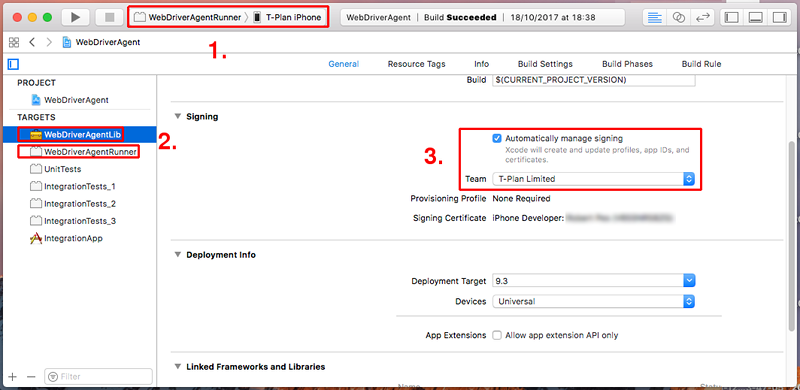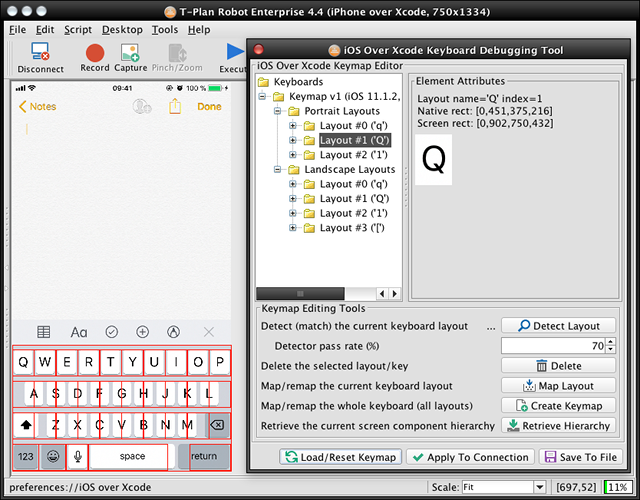Last update: 24 January
2018
Contents:
1. Introduction
2. Setting Up
3. Connecting From Robot
4. Troubleshooting
5. Automation
1. Introduction
NOTE:
For the older document describing automation of iOS
9 devices over Xcode 7 go here.
|
T-Plan Robot Enterprise version 4.3.1 and higher supports automation of iOS 10+
devices over Xcode 8 and higher on Mac OS X. Main features:
- Full iOS control enabled without jailbreak.
- No modification of the tested application is required.
- Device must be connected both to a WiFi network and to
Mac OS X over the Lightning
USB cable.
- Support of automation in the Portrait and Landscape
Left (with the device button on the right) screen
orientations.
- Extra set of features provided through the iOS
Over Xcode Extension plugin.
As the connection is slower than the iOS Mirror one it is not
suitable for testing of applications that require real time control,
such as games etc. Use the iOS Mirror
connection instead.
2. Setting Up
Requirements:
- Xcode installed, up to date and configured with a valid Apple
Developer account (matching provisioning profile, valid
certificate chain).
- The iOS device is connected over the Lightning USB cable to
the Mac machine and is accepted by Xcode (listed in Window
-> Devices).
1. Download Instructions:
- Download
the WebDriverAgent project version 4 from 20 August 2018.
- There's no upgrade from the old versions. Abandon the old
project and set up the new one from scratch.
- Don't use the official WebDriverAgent
project. We have added bug fixes and enhancements to enable
the landscape mode and full iOS control. There's a switch in
the connection preferences allowing Robot to
accept a custom project version but we don't guarantee its
functionality.
2. Project Setup Instructions:
- First time set up: Follow the set up instructions in
the project
page (or more detailed steps here).
In a nutshell:
- Install dependencies: npm, Carthage and GIT
- Run the
./Scripts/bootstrap.sh script
- Repeated set up (after project upgrade):
- Run the
./Scripts/bootstrap.sh script. If you
are asked to upgrade the dependencies do so and re-execute the
script.
3. Xcode Setup Instructions:
Xcode set up must be repeated:
- After you update or re-download the WebDriverAgent project.
- After the Xcode gets updated.
- After the iOS on the target device gets updated.
- If you need to set up a new device.
The steps:
- Start Xcode. Open the
WebDriverAgent.xcodeproj
project file from the app folder.
- In the Xcode project:

- Select the WebDriverAgentRunner scheme and
the target device at the top bar.
- Select the WebDriverAgentLib target. Make
sure that the "Automatically manage signing"
option is on and a valid team is set.
- Select the WebDriverAgentRunner target. Make
sure that the "Automatically manage signing"
option is on and a valid team is set.
- Select Product->Test in the
Xcode menu. Open the debug console through View->Debug
Area->Activate Console. If everything works OK
the application will start in the test mode and the console
output will contain a line at the bottom:
2017-10-19 15:51:28.502141+0100
WebDriverAgentRunner-Runner[785:276949]
ServerURLHere->http://192.168.1.3:8100<-ServerURLHere
- To verify that the WDA server works open the inspector in
Safari using the URL below. It should display a device screen
shot and its component hierarchy. It's OK if the page is not
populated on slower devices such as iPads where retrieval of the
necessary data is painful slow:
http://192.168.1.3:8100/inspector
Robot doesn't need Xcode to run at the time of the
connection. The WebDriverAgent application doesn't even have to be
installed on the target iOS device. Robot will start
it and eventually build it and install it on the device using the
Xcode CLI tools. The manual process above is required only to
ensure that the WDA project is configured properly to be built and
executed using the Xcode CLI tools. It will also compile the code
which shortens the connection init time.
3. Connecting From Robot
You must provide:
- Name of the device you wish to connect to
- Path of the properly configured WDA project
NOTE: Keyboard mapping may be very slow, especially on
iPads where it may take up to 10 minutes. Use the stored keymap
option to avoid the delay for repeated connections.
4. Troubleshooting
- Make sure to use the original Lightning USB cable shipped
with your iOS device. Apple is known for making the iOS refuse
cables from other producers.
- Connect the cable directly to the Mac's USB port. Do not use a
USB switch or hub.
5. Automation
To connect to an iOS device from a test script use the Connect command (TPR scripts) or
the connect()
method (Java test scripts). The argument URL must be in form
of "xcode://localhost"
For example, the following command/method call will connect you to
the first detected device:
TPR test scripts:
Connect xcode://localhost device="My
iPhone" app="/Users/Joe/myapp.ipa"
Java test
scripts: connect("My
iPhone", new
File("/Users/Joe/myapp.ipa"), false, false
Another alternative is to encode the parameters to the connect URL
query. This form is also suitable for the -c/--connect CLI connection. You may copy the URL of any
of your recent connections from the Tools->CLI Wizard
window. Another alternative is to give your connection a name in the
Desktop->Connection
Manager window and then use it instead of the URL.
TPR test scripts: Connect "xcode://localhost?device=My%20iPhone&app=/Users/Joe/myapp.ipa"
Touch Screen Support
Only Portrait and Landscape Left
screen orientations are supported. Other ones won't break the
connection but the touch events (taps, ...) are likely to be
misplaced. This is due to a bug in the underlying framework by
Apple.
To change the screen orientation press the F4 key or make
your test script press it (Press F4). This is supported
since v4.4.3.
The mouse gestures are interpreted as follows:
- Mouse clicks are mapped onto the touch screen taps. Double
clicks (taps) and long clicks (long taps, "touch and hold") are
supported since v4.4.2.
- Mouse drags are mapped onto swipes.
- Mouse wheel events are not supported and they are ignored.
- Other touch screen gestures may be supported through the iOS
Over Xcode Extension plugin.
Keyboard Support
Hardware key mappings:
iOS Hardware Key
|
Robot
Script Key (Action)
|
Description
|
HOME
|
Home, Right mouse click
|
Home key. Long press and double Home press is
not supported.
|
<screen rotation>
|
F4
|
Rotate the screen from
Portrait to Landscape Left or vice versa.
|
Other keys are simulated through the soft keyboard. The connection
acts as an end user, i.e it switches through the keyboard pages and
taps individual keys (characters). Rules:
- The keyboard must be visible to type anything. Typing
while the keyboard is off will be ignored.
- Only one keyboard locale (language) is supported at a
time. Do not switch among keyboards during automation as it will
result in wrong keys being typed.
- The connection supports only keys that are on the current
keyboard.
- Some keys may not be available when the device is in the
portrait mode. For example, you can't press the "Hide keyboard"
key on iPhone in the portrait mode because the keyboard contains
it only in the landscape one.
- Extra keys from the list displayed on a long key press are not
supported.
- The Emoji keyboard is not supported. The workaround is to
automate using mouse clicks.
Most keys on the soft keyboard are equivalent to the PC keyboard
(a-z, A-Z, 0-9 etc.). The outstanding soft keyboard mappings are
summarized at the table below. Availability of the keys marked with
a red asterisk may be subject to the device type and screen
orientation.
iOS Keyboard Key
|
Robot
Script Key (Action)
|
Description
|
ENTER, GO
|
Enter (new line)
|
The Enter key.
|
DELETE
|
Backspace, Delete
|
Backspace key.
Deletes characters before the insertion point. |
 SHIFT SHIFT
|
Up (Arrow
Up)
|
The shift
key switches the keyboard to shifted characters.
It's label and/or appearance changes depending on the
keyboard page.
You don't have to press this key manually to type a shifted
character
because the connection will switch it on its own.
|
 MORE MORE
|
Right
(Arrow Right)
|
The shift
key switches the keyboard to the next keyboard page.
It's label and/or appearance changes depending on the
keyboard page.
You don't have to press this key manually to type a
character from another page
because the connection will switch it on its own.
|
 NEXT KEYBOARD NEXT KEYBOARD
|
F5
|
The key
switches to the next keyboard locale. As the connection
supports
(maps) just one locale you may interact with the next
keyboard only through taps.
To restore the typing support you must switch back to the
base keyboard locale.
|
 DICTATION DICTATION
|
F6
|
Starts
dictation.
|
Keyboard Mapping
The connection performs keyboard mapping on the start up. It
is a process where it displays all pages (called "layouts") of the
current keyboard and records location of its keys. As this is a slow
operation it is recommended to enable storing of the map to a file.
The mapping will be performed just once and the subsequent
connections will reuse it. Be aware that any keyboard change will
invalidate the map, namely switching to another locale (language).
Update of the iOS may also introduce changes which invalidate it.
The initial keyboard mapping is performed against the keyboard
displayed for the URL field of the Safari browser. As other apps may
use a different set of keyboard keys or customize the keyboard the
Safari map may not work properly. To fix or re-create the keyboard
map manually using the Desktop -> iOS Over
Xcode Keymap Editor window:

- To identify the currently displayed layout select Detect
Layout.
- The Create Keymap button will repeat the whole
mapping process to create a new keyboard map.
- To recreate or fix an individual layout displayed on the
device screen select Map Layout. For example the
'Q' layout in the above screen shot is not applicable to the
Notes application because Safari adds a few extra keys to it. To
make the characters type properly it must be remapped.
- To add a missing layout use Map Layout as
well. For example the map above contains just three portrait
layouts. To add the '[' one make it displayed on the screen and
map it.
- Use Delete to delete keys you want the scripts
to ignore. Though you may also delete layouts it's not
recommended unless you are about to recreate them.
- To apply the changes to the current connection session click Apply
To Connection.
- To save the changes to the keymap file click Save To
File. The map will be loaded by the subsequent
connections if the stored keymap flag is enabled.
For script driven keyboard remapping check the iOS
Over Xcode Extension plugin (pending).
To delete the current map file and eventually re-create the default
Safari one:
- Open the Login Dialog, select the "iOS
Over Xcode" connection and click the "..."
button next to the "Device name" field
- The window will show the list of devices connected over USB
and indicate whether a device keyboard map has been created. Use
the "Delete Keyboard" button to delete the
invalid keyboard(s).
- Connect again with the stored keymap option enabled to create
a new Safari map.
WARNING: The connection forces the screen
orientation change during the keyboard mapping process. As this
step sets off the built-in gyroscope you won't be able to change
the screen orientation by manual device rotation. To re-enable
this functionality re-plug the device to the USB and avoid
programmatic orientation change through reconnection using the
stored keyboard.
 SHIFT
SHIFT MORE
MORE NEXT KEYBOARD
NEXT KEYBOARD DICTATION
DICTATION